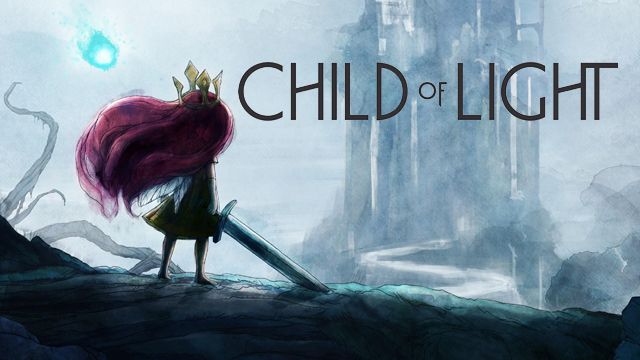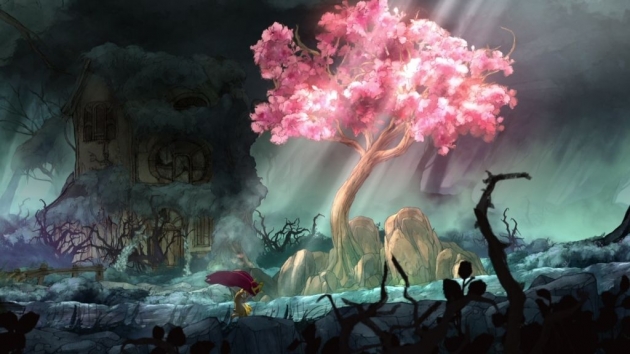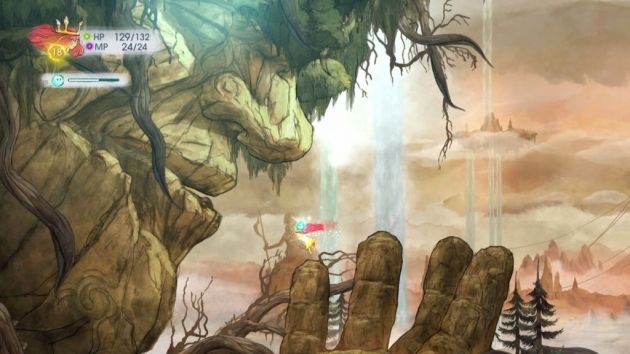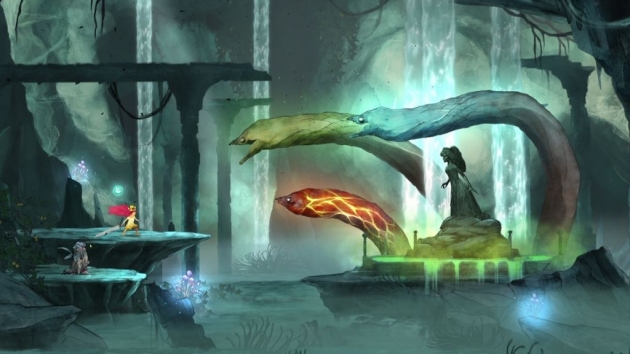Child of Light

The UbiArt engine has been used to bring us two gorgeous Rayman games and now the first RPG using it has been crafted. Child of Light has stunned people since it was first shown with its watercolor painting-inspired graphics. Now, the game is out and the breadth of its story can be told. A young girl named Aurora was taken from her home, leaving her duke of a father distraught. She awakens in a dream world full of mystery and strange creatures. Spiders that were once minor nuisances have become viable threats to her life, and nothing is as it seems.
Aurora’s goal is to find her father and if that means killing the man who took her, then so be it. Along her journey, she’ll encounter a number of allies and survive many traps. The first ally she meets is a bright blue firefly named Igniculus. He’s a blue energy-using creature that feeds on little bits of light found throughout the world. These things are used for his energy meter, and while it can refill slowly on its own, using the bits fills it up faster. The regular gameplay and battle system share a few mechanics thanks to him. Outside of combat, you can use Igniculus to heal you with the left trigger. In battle, you can do that and have him slow down enemies so you can get another turn in. This also lets you hang onto your potions without needing to worry about losing health. This mechanic may seem game-breaking, but since his meter refills slowly without help, and instant-refills on the battlefield are limited, you still need to use a careful mix of his healing powers, combat, and basic defense.
The active battle system features a very handy little meter on the bottom of the screen letting you know the general order of combat. This little addition to the HUD means there’s no guesswork involved in figuring out which character is up next, and you can time things with the enemy slowdown technique to really work in your favor thanks to this design choice. Skill trees allow you to enhance your abilities beyond the usual leveling up system, and there’s an alchemy system embedded into combat as well. You can pick up various elements called Oculi and bind them to your party’s equipment. This allows you to have certain buffs to things like fire or water, and dole out more damage using those elements. There’s a lot going on with the battle system, but it’s all really easy to learn and implement within the game itself.
On a surface level, the side-scrolling nature of things may not seem ideal for an RPG. However, just like with Paper Mario, it works out fairly well. Like those games, and Super Mario RPG before it, you can avoid enemies if you so desire while traversing through the worlds. In theory, you could just battle bosses and the few enemies who block your path. Doing so would be foolish though as you’ll be underpowered for major battles. Two party members engage in battle, but you can swap out an injured ally during a turn if you need to. In a great move, a party member gains XP even if they aren’t involved in combat – so you’ll never wind up with a new party member who is severely underpowered and needs a lot of grinding to bring up to speed.
The greater goal of Child of Light is to present a childhood storybook world in a video game. That mission is accomplished with a dramatic storyline that features a bizarre (but memorable) cast of characters. The narrative is told with soft colors in text form, while the environments are bursting with life in every pixel. Child of Light’s watercolor painting style is a visual stunner. However, one element that doesn’t shine through in screenshots is the animation. Aurora’s hair is one of the most impressive things you’ll see, as it flows fluidly in the air. The only real flaw I found with the graphics was the use of a fairly light text color for dialogue. Text scrolls against a while backdrop, which should in theory help that issue. However, the default color isn’t dark enough for that to really work, and continuing a conversation makes everything above the current text become a super-light shade of whatever color is used.
The slow and somber soundtrack is highlighted by a lot of stringed instruments. Child of Light’s soundtrack, like the Shenmue franchise and Journey, is heavily atmospheric. The key is that the music fits the scenes it’s used for, and pacing-wise, it’s kind of between those game franchises. It’s a lot more relaxed than most of what was featured in Journey, and has a slower pace to it like Shenmue. Like that, the OST is meant to be appreciated and savored. It’s not music that will hold up well in a group listening setting, but would stand tall when listened alone with a nice set of headphones. The voice over narration used to get the story moving in cutscenes is fantastic. Like the music, it’s subdued and relaxing.
Child of Light is a memorable RPG and a perfect pickup for anyone looking to get into the genre who might’ve lapsed a bit since the PS2 era. This game combines an easy-to-digest storyline with likeable characters and a stunning watercolor painting art style. It’s got a faster-paced battle system than you might expect for a debut effort in the genre from Ubisoft, and can be enjoyed by people in pretty much any age group. The plot can get a bit dark, but it’s mostly light-hearted and like Ni no Kuni, serious matters are rare and used to drive the plot forward in a big way. Given how grim a lot of fairy tales are, this is really no worse than them, and it could be a fine starter RPG much like how Super Mario RPG was nearly two decades ago. If you’ve been impressed by just the visual style, you’ll be glad to know that it’s worth buying for that at first, and then turns into an RPG you won’t be able to turn away from.
Reviewed By: Jeremy Peeples
Publisher: Ubisoft
Rating: 94%
——————————————————————————–
This review is based on a digital copy of Child of Light for the Xbox One provided by Ubisoft.
 Game Over Online
Game Over Online


















